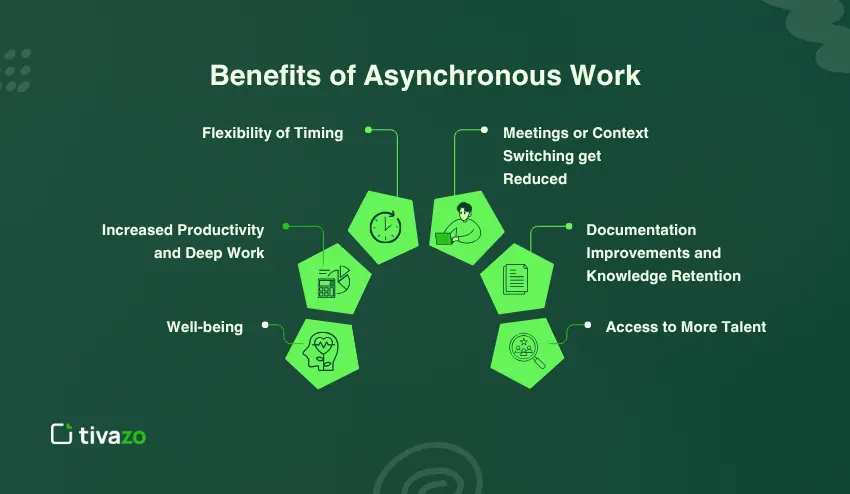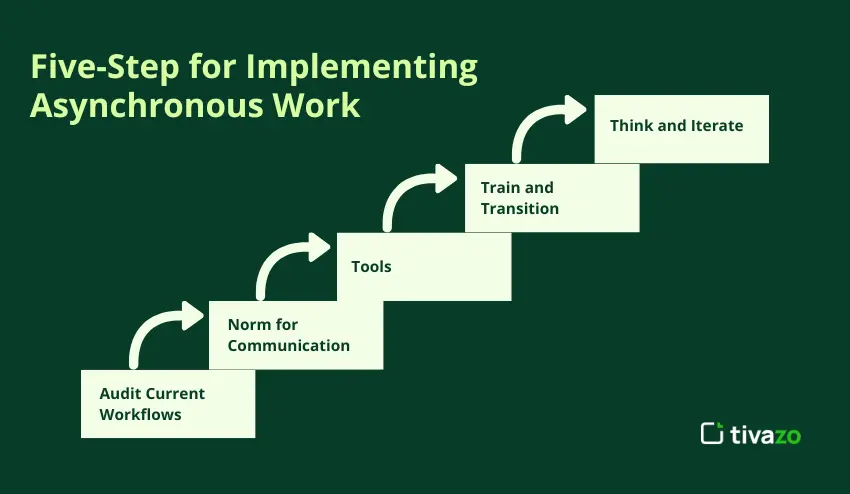The contemporary working environment has expanded beyond one office or time zone. Today, teams are spread across continents, working at home, at a coworking space, or at a café. In this global environment, asynchronous work has become more than a buzzword; it is how high-performing teams achieve and remain productive without being online at the same time.
Asynchronous work enables individuals to contribute, collaborate, and advance at their own pace. Instead of waiting for a meeting or instant response, each team member will document their updates, iterate based on other results, and manage their projects independently. This shared independence not only facilitates burnout but fosters deep-focus work, which can be difficult with a meeting-heavy environment.
In this guide, you will learn what asynchronous work is, why it’s valuable, how to implement it, and what tools will help facilitate async thinking. You will also find practical frameworks, real-world insights to manage async teams.
What Is Asynchronous Work?
An asynchronous work style allows people to work on their time schedules through tasks and communication. The team does not need to be simultaneously online, and asynchronous work uses written documentation, status updates, and software to streamline the process of working in coordination with each other.
For instance, a software engineer in Berlin can complete a feature, and then a designer in New York can later review their mockups that day. The two workers can not be together in a live meeting, but both are working away independently of each other, and sourcing the project work for the same intent.
A common misconception of asynchronous work is that no communication is involved in the work process. In reality, communication is occurring and is documented and structured. Teams share written documentation to provide status updates, share a task board, and record video messages. Written documentation provides transparency in the work and eliminates wasted time in meetings. Written asynchronous work allows individual team members to engage in deep work to be distraction-free.
Benefits of Asynchronous Work
There are many reasons that can contribute to the desirability of asynchronous work for remote, hybrid, and distributed teams.

- Well-being
By allowing employees to not be expected to reply immediately, asynchronous communication allows time to organize work and personal schedules towards greater work/life satisfaction to avoid burnout. - Increased Productivity and Deep Work
Without the constant interruptions of meetings and instant messages, an employee can spend much more time doing focused work with greater quality. The deep work helps boost and improve the quality and productivity of the work. - Flexibility of Timing
Distributed teams around the world can easily work together without every employee having to be online at the same time. Each team member brings value to the work when they feel their productivity is at its highest. This is much easier for global operations. - Meetings or Context Switching get Reduced
When meetings and decisions are documented, unnecessary meetings can be removed from employees’ worlds. Employees can become more fluid in their work, with less mental fatigue when forced to switch context. - Documentation Improvements and Knowledge Retention
Asynchronous workflows leverage documentation in the form of updates, task boards, and documented messages to communicate. The formal structure allows for everyone to easily reference decisions, project details, and the context now and in the future. - Access to More Talent
Organizations are no longer tethered to geography. Companies can find the best employees in the world, with specialized skills that the company needs at that time, who do not need to worry about overlapping working hours.
How Asynchronous Work is Different from Synchronous Work
Both asynchronous and synchronous work has the same goal of completing tasks, but the primary difference remains in time. Synchronous work so that team members are collaborating in real-time a meeting for example, a call, or instant message. However, asynchronous work allows people to work on their own time, relying on documents, in task findings using documented updates, task boards, and recorded communication.
Below is a brief summary to illustrate the comparison:
| Aspect | Asynchronous Work | Synchronous Work |
|---|---|---|
| Definition | Work done independently with delayed communication | Work done together in real time |
| Typical Tools | Email, Notion, Loom, Docs | Zoom, Slack huddles, live calls |
| Overlap Hours | None–Few | High |
| Speed of Decision | Slower but thoughtful | Fast but interruptive |
| Best Use Cases | Deep work, documentation-heavy tasks | Brainstorming, urgent issues |
| Pros | Flexible, less context switching, better focus | Immediate feedback, fast alignment |
| Cons | Slower decisions, requires discipline | Interruptions, meeting fatigue |
Numerous teams use a combination of both approaches. For instance, deep-focus work or tasks such as coding, content writing, or research should be done asynchronously, while brainstorming or urgent problem-solving is quicker and more effective in real time. Knowing when to deploy each style will provide a smoother workflow and greater productivity.
Types of Asynchronous Work
Asynchronous work can refer to some specific models depending on the needs of the team, team structure, and the requirements of the work itself. Identifying these variations will help teams choose the most appropriate way to work, while balancing flexibility against productivity.
Fully Asynchronous Teams
Fully asynchronous teams operate without live meetings. Team members work together, entirely through written updates, shared documents and/or task boards. This model is often a common practice in open-source projects or fully distributed companies.
Advantages: Maximum flexibility and very few, if any, conflicts.
Disadvantages: Measures can slow decision making and sometimes delay feedback.
Hybrid Asynchronous Teams
Hybrid teams marry the asynchronous work model with limited synchronous overlap. For example, a product team might have a two-hour window each day where team members might work together live, but all other work is asynchronous.
Advantages: Provides some real-time interaction without losing async flexibility.
Disadvantages: More scheduling and co-ordination, compared to a fully async team.
Asynchronous Communication vs Asynchronous Work
It is important that we recognize the distinction:
Asynchronous communication: Messages, emails, videos (etc) that are sent with a request for no response in real-time.
Asynchronous work: The broader model where the overall workflow is to be managed or completed without real-time, collaborative work.
Example: A team may send an async communication on a project and share the tasks collaboratively, in real-time on the worksheet planned for later.
Comparison Table: Models of Asynchronous Work
| Model | Overlap Hours | Flexibility | Speed | Ideal Use Cases |
|---|---|---|---|---|
| Fully Async | 0 | Very High | Slower | Open-source, research, content creation |
| Hybrid Async | 2–4 hrs | High | Moderate | Product development, remote ops |
| Synchronous | 6–8 hrs | Low | Fast | Customer support, urgent operations |
Five-Step Framework for Successfully Implementing Asynchronous Work
Whenever asynchronous work is implemented effectively, it takes a structured measure. The following five-step framework supports teams transitioning into asynchronous work while encouraging productivity and collaboration.

Stage 1 – Audit Current Workflows
Identify which tasks require you to be synchronous with in-the-moment input and which tasks can be completed asynchronously. Be sure to audit the recurring meetings, decision points, and any dependencies.
Micro-example: A design team audits its weekly meetings and finds that 60% of the work could be done without a live meeting; this saves the design team four meetings (10-6) every week.
Stage 2 – Norm for Communication
Identify which channels for updates, response time, and documentation expectations are needed for the team. The communication norms should be explicit in order to provide clarity and allow for async collaboration.
Micro-example: A product squad adopted a “48-hour reply rule” for internal team responses, which improved communications on Slack and reduced unnecessary Slack notifications by 40%.
Stage 3 – Tools
Select tools available for project management, documentation, and async video that fit within the workflows of your team. The tools must allow the team to see updates, track progress, and provide accountability.
Micro-example: An engineering team can communicate work updates using Loom for a status update and can also see the workflow in a central project work board while increasing review throughput without more live or in-person meetings.
Stage 4 – Train and Transition
Implement the async strategy with select teams, train with templates and role specific guidance, and focus on hands on training to help them best leverage the async approach.
Micro-Example: Customer Support dept/executive sponsor uses a four week async piloting approach, all while maintain CSAT, and reducing live meeting hours
Stage 5 – Think and Iterate
Identify and establish metrics such as task completion, engagement, and meeting reduction, and adjust based on the need to continue to improve workflow.
Micro-Example: After three months, a hybrid of remote and in-person, meeting-free team reports 25% fewer meetings while meeting project delivery deadlines.
6 Suggestions on Leading Staff in Asynchronous Environments
Leading staff in asynchronous environments means requiring practices that allow for productivity, collaboration, and engagement. Here are six practices:
- Hire for Writing Abilities
In an async environment, clear and concise writing is the key aspect of the environment. A candidate who can document ideas, updates, policies and decisions is essential. - Document Decisions and Processes Immediately
Encourage your team members to make updates on shared boards, wikis, or task logs in real-time. This can reduce confusion and unnecessary repetitive questions. - Encourage Ownership of Work as Well as Autonomy
If you are able to assign specific responsibilities, the team member will know (or can at least prioritize) what they should be working on independently. This also creates necessary accountability. - Use Shared Dashboards to Show Progress
Using things like project boards or dashboards can give a quick overview of what the task progress is like without needing to check-in in real-time. - Bring Teams All Together as a Unit Asynchronously
Regular written updates or “end-of-week notes” can help keep culture and cohesion together without the need for everything being checked in on in real-time. - Constantly Review and Refine Norms
Assuming everything is working well is the worst mindset to have in a team. Schedule check-ins at regular intervals if advances to a productive workflow, tools, and communications have been made.
Example: A remote marketing team does weekly asynchronous updates and uses dashboards, and they have reduced the number of meetings by 50% and the visibility of the work is perceivably much higher.
When to Choose Asynchronous Work Over Synchronous Work
Not every task is conducive to working asynchronously. Being aware of when to or not to utilize async versus synchronous collaboration is a valuable tool for maintaining efficiency and eliminating delays.
There are ideal to use asynchronicity:
- Distributed Teams Across Time Zones: Team members can work on the same project and contribute asynchronously without needing overlapping working hours.
- Deep-Focus or Solo Work: Coding, writing a report, or conducting research all require uninterrupted thinking as one works through the task, and focusing deeply is easier and better done alone.
- Conference Report or Documentation: Updates regarding status, reporting, and hand-off items can be shared without requiring a meeting.
When synchronous communication is more appropriate:
- Urgent Decisions or Crisis: When someone needs an answer right away, there is no time for asynchronous communication or collaboration as costs can quickly escalate if decisions are delayed.
- Ideation or Creative Work: In moments of ideation, it is vital to hear feedback from others in real-time in order to build ideas, innovate, and ensure productivity.
- Alignment in Teamwork on Complex Projects: Ownership of complex projects can often lead to confusion by requiring team members to clearly communicate and align in real-time as the project progresses.
Decision Table: When to Use Async vs Sync
| Task Type | Best Approach | Notes |
|---|---|---|
| Deep work | Asynchronous | Focused, uninterrupted time |
| Status updates | Asynchronous | Documented and trackable |
| Urgent issue | Synchronous | Immediate resolution |
| Brainstorming | Synchronous | Real-time ideation |
By assessing each task, teams can strategically balance async and sync workflows, improving productivity while minimizing unnecessary meetings.
Communication in Teams using Asynchronous Work
Effective communication is the most important aspect of asynchronous work. Since team members aren’t working together in real-time, clarity, context, and consistency will likely become much more important than if the team were working together in real-time.
Best Practices for Async Communication:
- Write Clear, Context-oriented Messages – Include background, deadlines, and expectations with updates for team members to gather context and reduce back-and-forth questions.
- Medium Matter – Use written updates for standard progress, Loom/video messages for demonstrations or walkthroughs, and shared docs for decisions.
- Establish Response Time Expectations – Communicate an expected timeframe (for example, 24 – 48 hours) for team members to wait for a response.
- Use Structured Templates to Update Team Members – Using a structured approach to how team members provide asynchronous updates (for example, Yesterday / Today / Blockers) ensures consistent updates and easier reading.
Common Mistakes and How to Fix Them:
- Too Long of a Message: Break up the content for easy scanning (sections/bullets)
- No Context: Include appropriate links/screenshots/references to previous messages
- Feedback Lag: Set a schedule for every week to evaluate (to prevent bottlenecking).
For Example: The remote product team used Loom videos for a weekly sync up on progress. Each person recorded their progress, any blockers, and any questions for the team, so they could avoid doing a stand up together live on a call each week, and would provide enough content for everyone to know where everyone else was at.
Typical Mistakes & How to Avoid Them
Even seasoned teams face challenges with async work if mistakes they repeat aren’t acknowledged. Here are the common mistakes, as well as ways to determine a fix.

- Not Much Communication Norm
Lacking clear channels for communication, timelines for communicating, or formats for providing async updates leads to communication getting lost and work being stalled.
Solution: Create an async playbook identifying processes, tools, and asynchronous habits/expectations. - Too Much on Chat
When a team goes to messaging apps for everything, miscommunications can occur, and information is not centralized.
Solution: Commit to documentation-first for decision-making and communication of updates, centralized instead in a board or wiki. - Onboarding is a Mess
New team members have no idea where the team is in their async workflows, tools, and norms, so they are left to fend for themselves.
Solution: Create role-based onboarding training either live or recorded, templates, and instructions for participation in async teamwork. - No Metrics to Measure Effect
Teams feel their async work is helping or productive, but they don’t ever track it to determine if they are correct or incorrect about their practice.
Solution: Measure a few KPIs and report as a team every month like how long it takes to complete a task that is done async, new meetings in that month, and overall engagement.
Tools to Facilitate Asynchronous Work
Having the right tools in place is key to effective asynchronous work. The right tools give you visibility, documentation, and ability to collaborate together – without working at the same time.
- Documentation & Knowledge Base
Notion, Confluence, Slite – All serve to consolidate documentation, SOPs, and meeting notes about work in the project.
Great for keeping everyone on the same page, documenting decisions and changes, and sharing information across time zones. - Project Management & Task Management
Asana, ClickUp, Trello – Allows teams to develop tasks, assign ownership, and visualize project and team workflow.
Also have features like task dependencies, due dates, and boards to keep progress on track. All of these support asynchronous collaboration. - Async Video & Feedback Tools
Loom, Vimeo Record – Record walkthroughs, demos or just general updates for your team.
Where text can be vague for a complex task process, a video is a better option and could even replace a synchronous meeting. - File Sharing / Document Handoffs
Google Drive, Dropbox – Each tool allows you to store & share documents, spreadsheets and other media.
These could all be helpful for keeping information in a centralized area that all team members can access anytime.
How Tivazo Supports Asynchronous Workflows
Tivazo is a tool for asynchronous workflows in a clear, effective, and accountable way. It will help teams track, document and optimize work without always being dependent on a real-time check-in.
- Measures and Optimizes Workflow For Async
User analysis allows teams to determine if their overall scheduling and time logging workflow is improved by going async. - Clear Time Tracking & Visibility Regardless of Where Work is Being Performed
Users are able to log hours and projects from anywhere across the globe, during different time zones. Managers are able to assess contributions without needing to have a live status meeting.
Example: A developer in Berlin and a designer in Kathmandu could both log work projects, while the lead designer could check activity heat maps asynchronously. - Automatically Structured Reports & Documentation-Ready Outputs
Tivazo will convert logged time tracking into shared insights, especially valuable for async updates and work tracking.
Example: Simple CSV documents of logged contributors, projects, etc. will reduce synchronous status meetings based on “what did you do today” type questions. - Measured Scheduling for Work
With the work-from-home and in office teams, Tivazo tracks idle, active, and wasted time so you can work based on scheduling.
Example: Hybrid teams can log hours, projects, and contributions during the hours when players are actively available, and provide some oversight and accountability without a synchronous check-in meeting.
Conclusion
Asynchronous working allows teams to work together productively, minimizes unnecessary meetings, and allows working on high value tasks. By embracing async work styles, organizations leverage flexibility, access to global talent, and increased productivity, while promoting transparency and accountability.
Regardless of the situation such as fully remote, hybrid or multi-time zone teams, async workflows can completely change the way work gets done. Successful implementation begins with establishing clear norms, tools, and measurement. Small steps will lead to big change!
To help the transition, consider Tivazo. Its time-tracking, reporting and analytics makes asynchronous work visible, measurable and actionable, empowering teams to reduce overlap, work more efficiently and streamline workflow in a way that does not require live check-ins.




